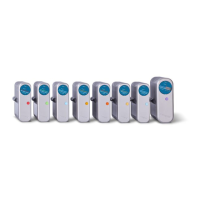ENGINEERING MANUAL OF AUTOMATIC CONTROL
INDOOR AIR QUALITY FUNDAMENTALS
157
HEALTH CARE OCCUPANCY
Health care occupancies have process contaminants similar
to office occupancies. Additional health care process sources
are anesthetic gases and sterilizers, infectious diseases including
drug resistant tuberculosis (TB), and lint from bedding. Because
many patients have weakened immune systems, higher priorities
must be given to the disease sources.
INDUSTRIAL OCCUPANCY
Indoor contaminant sources in industrial occupancies
generally are dominated by the processes taking place. Most
concern is concentrated on the materials, solvents and by-
products of a process which is moderately or highly toxic, with
little concern for lesser sources. The traditional approach to
industrial air quality has been to capture the process air, exhaust
it to the outdoors, and provide sufficient make-up air to replace
the exhaust component.
If the more toxic sources are controlled, the lesser sources
are assumed to be under control. The Occupational Safety and
Health Agency (OSHA) sets maximum safe levels for most
common and dangerous materials and requires that materials
safety data sheets be completed on each of these substances.
The National Institute of Occupational Safety & Health
(NIOSH) also publishes a list which includes additional
substances and a value index for items Immediately Dangerous
to Life and Health (IDLH).
Occupant Related Contaminant Sources
Humans and animals emit a wide array of pollutants by breath,
sweat, and flatus.
For example CO
2
is generated by people in all types of
buildings, and there is a measurable correlation between
occupant activity and CO
2
. In office structures and non industrial
facilities CO
2
is a major consideration. In Health Care facilities
humans are also a source of infectious bioaerosols, including
drug resistant TB. Tobacco smoke is a major contaminant. Its
use has declined in most occupancies except for a concern for
residences and bars. The human tracheo-bronchial system
serves, somewhat, as a pollution control device by acting like a
saturated adsorber by removing a portion of contaminants such
as VOCs.
For a detailed discussion of odors refer to ASHRAE
Fundamentals Handbook 1997, Chapter 13, Odors.
CONTAMINANT TYPES
Particulate Contaminants
Particulates consist of aerosols, dust, fumes, and smoke and
contain a wide range of materials, types, and sizes. Particulate
contaminants can be solid, liquid-gas dispersoids, or soils.
Aerosols include viruses, bacteria, fungus spores and pollen.
Particle sizes vary from 0.001 to several thousand micrometers.
Solid particles smaller than 100 micrometers are classified as
dust. Fumes are solid particles formed by the condensation
vapors of solid materials starting as air borne particles smaller
than 1 micrometer and accumulating with age to larger clusters.
Smoke is small solid and/or liquid particles produced by
incomplete combustion of organic substances. Smoke particles
vary from in size from 0.01 to 1 micrometer.
Figure 1 lists a variety of common particles found in the air.
This figure also illustrates the effectiveness of an electronic air
cleaner when compared to a standard furnace filter.
Fig. 1. Characteristics of Particles.
AIR CLEANER PARTICLE CHART
Particles visible
with . . .Particle
Size in Microns
HONEYWELL EAC
EFFECTIVE RANGE
DUST/LINT FILTER
EFFECTIVE RANGE*
PARTICULATES
Human Hair
Viruses
Bacteria
Skinflakes
Pollen
Plant Spores
Sneeze Droplets
Dust Mites
SMOKE
(PARTICLES)
Carbon Particles
Cooking/Grease
Tobacco Smoke
Wood Smoke
DUSTS
Household Dust
Insecticide Dusts
Soil Dust
Coal Dust
Animal Dander
ATMOSPHERIC
PARTICLES
Smog
Clouds/Fog
Mist
100101.1.01
.001
Naked Eye
Optical
Microscope
Electron
Microscope
THE EFFICIENCY OF DUST/LINT FURNACE FILTERS DECREASES
RAPIDLY ON PARTICLES BELOW 100 MICRONS, AND ARE VIRTUALLY
INEFFECTIVE ON PARTICLES BELOW 10 MICRONS.
*
M1248B

